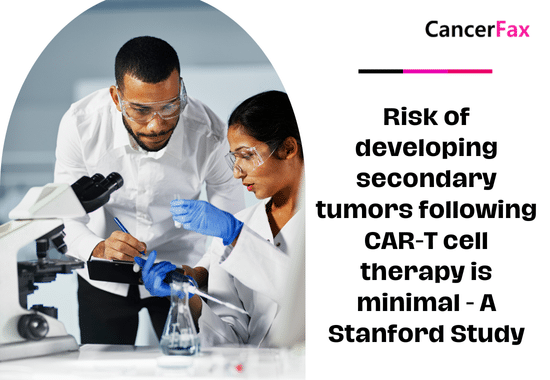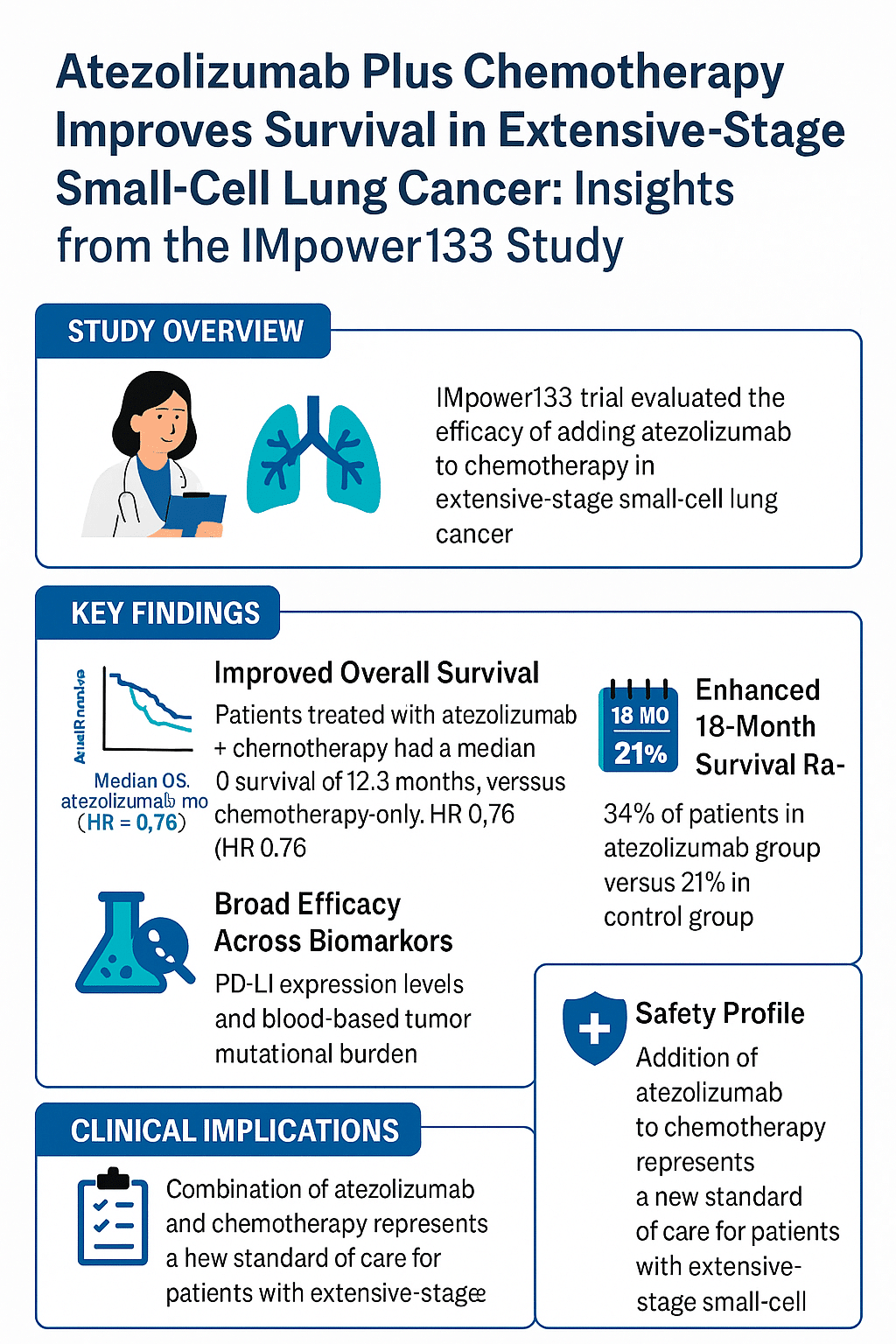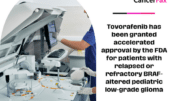Risk of developing secondary tumors following CAR-T cell therapy is minimal – A Stanford Study
June 2024: The chances of getting secondary blood cancers after CAR-T cell therapy, a cell-based cancer treatment that got a lot of attention in 2017 for being effective against hard-to-treat blood cancers, are very low, according to a thorough study by experts at Stanford Medicine. This is despite a warning from the Food and Drug Administration.
The FDA issued a warning in November 2023 regarding the potential risk of developing secondary cancers, specifically blood cancers, that may be linked to CAR-T cell therapy. Prior to the warning, there was an increasing level of worry due to reports of patients being diagnosed with T cell malignancies that were not related to the malignancy they were being treated for.
Nevertheless, the analysis of more than 700 individuals who received treatment at Stanford Health Care revealed that the probability is minimal, approximately 6.5%, within the three-year period following therapy. Researchers have shown that the lone instance of deadly secondary T-cell malignancy was most likely caused by the immunosuppressive effects of CAR-T cell therapy, rather than the CAR-T cells themselves. The patient’s impaired immune system facilitated the rapid growth of pre-existing cancer cells that had not been previously recognized.
“In order to comprehend this exceptional instance, we thoroughly examined all the patients who underwent CAR-T cell therapy at Stanford with comprehensive scope and conducted an in-depth analysis of this singular case,” stated Dr. Ash Alizadeh, a professor of medicine and a member of the Stanford Cancer Institute. “By analyzing protein levels, RNA sequences, and DNA from individual cells in various tissues and time points, we concluded that the therapy did not cause the lymphoma in this patient. Instead, the lymphoma was already present in their body at very low levels.”
The study’s findings might allay some concerns raised by the FDA’s “black box” warning, which is a prominent notice on drug labels that warns of potentially dangerous side effects. Furthermore, it could assist researchers and doctors in identifying individuals who are more susceptible to developing secondary malignancies and are potential candidates for CAR-T cell therapy.
While it is improbable that these patients would refuse treatment that may potentially save their lives in order to prevent a slight chance of developing cancer in the future, it would be advisable to constantly follow them after the therapy or conduct comprehensive screenings for other types of cancer before starting CAR-T cell treatment.
Authors and publishers
Alizadeh, the Moghadam Family Professor and leader of the Cancer Genomics Program at the Stanford Cancer Institute, and David Miklos, MD, PhD, professor of medicine and chief of bone marrow transplantation and cellular therapy, are the senior authors of the study. The study was published on June 12 in The New England Journal of Medicine. Postdoctoral researchers Troy Noordenbos, MD, and Mark Hamilton, MD, PhD, are primarily responsible for the research.

The problem with treatment of cancer
The concept of a cancer treatment leading to the development of additional cancers is not novel. Standard chemotherapy and radiation therapies for many tumors can induce genetic abnormalities in previously healthy cells, leading them to disregard the biological mechanisms that regulate cell division. Although cancer treatment in the USA is more advanced than in any other country on the planet, there is still a long way to go.
During CAR-T cell treatment, T cells, which are a type of immune cell, are extracted from a patient and modified genetically to enhance their ability to specifically target and eliminate cancer cells. In order to accomplish this, scientists insert a specially designed gene into the DNA of the T cells. This gene contains the genetic information necessary for the production of a protein known as a chimeric antigen receptor. This receptor has the ability to identify and attach to cancer cells. When T cells produce this protein and attach it to their surfaces, they become highly effective in destroying cancer cells.
During the development of the therapy, researchers employed genetic engineering techniques to ensure that the implanted gene would not interfere with regular cellular processes. However, if the gene responsible for the newly formed protein is incorrectly placed within the genome, it has the potential to deactivate or alter genes that play a crucial role in important cellular processes, such as regulating cell development. In the event of this occurrence, the T cells intended for therapeutic purposes may undergo malignant transformation instead.
Following the FDA’s announcement in November regarding the investigation of secondary cancers, Miklos and his colleagues recognized that Stanford Medicine’s extensive biobank of tissue and blood samples from individuals undergoing CAR-T cell therapy could provide crucial insights. These samples could shed light on the comparative risk of secondary cancers and determine whether these cancers originated from the manipulated T cells. They collaborated with experts in Alizadeh’s group to perform a comprehensive analysis of the DNA sequences, RNA messages (which provide insight into the proteins produced by a cell), and proteins in the samples.
The researchers examined the results of CAR-T cell therapy for 724 individuals who received treatment at Stanford Health Care from 2016 to 2024. Within this group of individuals, the prevalence of secondary blood malignancies reached approximately 6.5% throughout a median period of three years of observation. This rate is comparable to that observed in patients who received stem cell transplantation instead of CAR-T cell therapy for their cancer treatment. Just one individual experienced rapid development and subsequent death from a T cell malignancy known as T cell lymphoma immediately after undergoing CAR-T cell therapy.
The researchers employed molecular, cellular, and genetic investigations, including innovative genetic profiling tools developed by Alizadeh’s team, to compare the tumors, CAR-T cells, and healthy cells of all 724 patients at various time intervals prior to and during CAR-T cell therapy.
“The study’s first authors demonstrated an impressive and highly skilled effort, working collaboratively and intensely from shortly before Thanksgiving until Christmas,” stated Alizadeh.
The investigation revealed no indication that the T cells accountable for the patient’s subsequent malignancy were the T cells modified for the CAR-T cell therapy. These T cells were determined to be different in terms of their molecular and genetic characteristics. Nevertheless, both groups of T cells were infected with a virus that is recognized to contribute to the development of cancer. Moreover, the patient had a previous medical record of autoimmune disease prior to their initial cancer diagnosis.
The study’s results suggest that second cancers that appear after CAR-T cell therapy might be due to immunosuppression or the bad effects of the treatment, not because the gene for the chimeric antigen receptor was put in the wrong place when the T cells’ genes were changed.
“These findings may assist researchers in directing their attention towards the immune suppression that can occur before and after CAR-T cell therapy,” stated Miklos. It is crucial to comprehend how CAR-T cell therapy affects the chance of developing cancer, especially as the focus of this area shifts from treating severe, difficult-to-treat blood malignancies to less risky but still significant conditions such as autoimmune illnesses.
This study has the potential to serve as a model for how to effectively document and analyze the results of CAR-T therapies, enabling us to gain a comprehensive understanding of their advantages and disadvantages,” stated Alizadeh. “These therapies are potentially life-saving and have a minimal risk of causing secondary cancers.” The challenge lies in determining the patients who are more susceptible to higher risk and understanding the underlying reasons for it.
The research was financially supported by many organizations, including the National Institutes of Health (projects R01CA233975, NCI P01 CA049605), the Leukemia and Lymphoma Society, the Lymph & Co Foundation, the Virginia and D.K. Ludwig Fund for Cancer Research, Kite-Gilead, and Adaptive Biotechnologies.
Dr. Nishant Mittal is a highly accomplished researcher with over 13 years of experience in the fields of cardiovascular biology and cancer research. His career is marked by significant contributions to stem cell biology, developmental biology, and innovative research techniques.
Research Highlights
Dr. Mittal's research has focused on several key areas:
1) Cardiovascular Development and Regeneration: He studied coronary vessel development and regeneration using zebrafish models1.
2) Cancer Biology: At Dartmouth College, he developed zebrafish models for studying tumor heterogeneity and clonal evolution in pancreatic cancer.
3) Developmental Biology: His doctoral work at Keio University involved identifying and characterizing medaka fish mutants with cardiovascular defects.
4) Stem Cell Research: He investigated the effects of folic acid on mouse embryonic stem cells and worked on cryopreservation techniques for hematopoietic stem cells.
Publications and Presentations
Dr. Mittal has authored several peer-reviewed publications in reputable journals such as Scientific Reports, Cardiovascular Research, and Disease Models & Mechanisms1. He has also presented his research at numerous international conferences, including the Stanford-Weill Cornell Cardiovascular Research Symposium and the Weinstein Cardiovascular Development Conference.
In summary, Dr. Nishant Mittal is a dedicated and accomplished researcher with a strong track record in cardiovascular and cancer biology, demonstrating expertise in various model systems and a commitment to advancing scientific knowledge through innovative research approaches.
- Comments Closed
- June 18th, 2024






Cancer relapse prevention, CAR-T cell genomic safety, CAR-T therapy safety, CAR-T treatment outcomes, Immunotherapy side effects, Long-term CAR-T effects, Secondary cancer risk, Stanford CAR-T study
CancerFax is the most trusted online platform dedicated to connecting individuals facing advanced-stage cancer with groundbreaking cell therapies.
Send your medical reports and get a free analysis.
🌟 Join us in the fight against cancer! 🌟
Привет,
CancerFax — это самая надежная онлайн-платформа, призванная предоставить людям, столкнувшимся с раком на поздних стадиях, доступ к революционным клеточным методам лечения.
Отправьте свои медицинские заключения и получите бесплатный анализ.
🌟 Присоединяйтесь к нам в борьбе с раком! 🌟